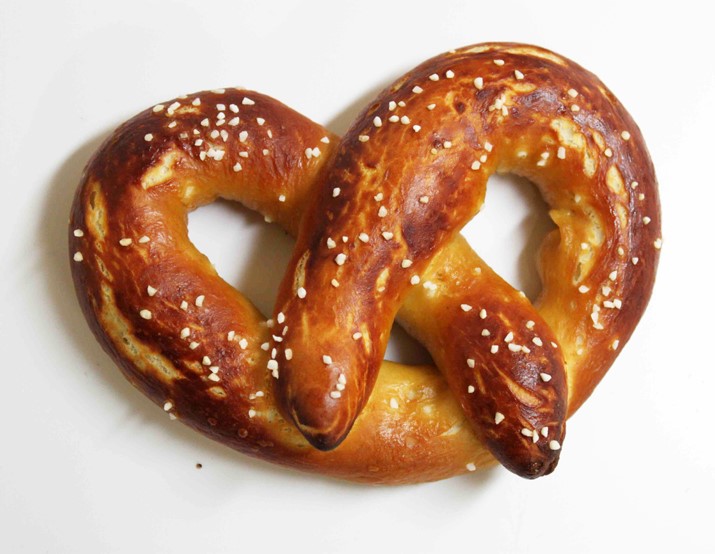This article originally appeared in the April 1948 issue of the Historical Review of Berks County.
Story by ANNE C. FRIEDMANN
A year or two before the Civil War, a pretzel baker moved with his family from the Moravian Village, Lititz, to Reading, then a city of some 20,000 inhabitants. And today, just 88 years later, Reading is the pretzel capital of the world.
An article in the Lancaster “Volksfreund” of July 30, 1879, states that “the first pretzel in the United States is said to have been baked in the city of Lancaster by one Scherle in the year 1827. He was followed by Ambrose Ranch in Lititz and later by a baker in Reading.”
The pretzel baker, Ambrose Ranch, had an apprentice, Julius Sturgis, who is generally credited as being first in America to establish pretzel baking as an industry, back in 1861, in Lititz. The Sturgis family has remained in the business ever since. There are two Sturgis pretzel plants in Reading today. Victor Sturgis, of West Lawn, was incorporated in 1924, followed by a cousin, Tom Sturgis, of South Second Street in 1928.
The baker in Reading, mentioned by “Der Volksfreund,” was Benjamin Lichtenthaler. He was born in Lititz on March 17, 1817. Lichtenthaler began baking pretzels which soon won great popularity throughout this and adjoining states. His factory was located at 37 Apple Street and later at 207 Cherry Alley. At the time of his death, in 1893, the factory output was 1,500,000 pretzels a year. The Lichtenthaler Bretzel Company was succeeded by the Pennsylvania Bretzel Company in 1900.
The local pretzel bakeries, incidentally, spelled their product “bretzels” as late as the early 1900’s. The only concern in Reading which has retained the original spelling is Billy’s Butter Bretzels, established in 1931 by William R. Edmundson at 242 Plum Street.
If Mr. Lichtenthaler established his bakery in 1860, the year he came to Reading, the where and when of the beginning of the pretzel industry in this country might be disputed and if “two teams constantly on the road,” comprise an industry, even Mr. Lichtenthaler may have to yield his laurels to John Sauermilch, Sr., of Boyertown, who started baking pretzels in that place about 1846.
In the Reading “Weekly Eagle,” of Feb. 25, 1893, there appears an interesting article, entitled “An Old Pretzel Baker.” From this source we learn that John Sauermilch, Sr., the subject of this article, was born in Germany in 1808 and that he learned the pretzel trade from his father, who was an expert baker in Germany. Sauermilch came to America when he was twenty years old. After working as a lime burner for eighteen years, he established a bakery in Boyertown, where he made pretzels just as his father had taught him in Germany. At the time the Eagle correspondent interviewed Mr. Sauermilch, the old, retired pretzel baker claimed that his pretzels had been in their day quite as popular as the Lichtenthaler pretzels of that time.
Then the Eagle reporter asked why it was that so few bakers could make a first class pretzel. Mr. Sauermilch answered, “They don’t understand pretzel baking and yet think themselves proficient in the work. It is a trade by itself. Some bakers take only bread dough for their pretzel. The proper pretzel dough differs widely from bread dough.”Mr. Sauermilch said at the time, “Americans are in many things ahead of the old country, but not so far as pretzels are concerned. In the United States it is much more difficult to find a good pretzel, than in Germany to find a bad one.”
We leave Mr. Sauermilch and his reporter friend, discoursing upon the pleasant pastime of drinking beer (something which, according to Mr. Sauermilch, Americans did not know how to do either) and on eating pretzels in a beer garden along the Rhine.
Patriotism notwithstanding, Mr. Sauermilch was correct about the number of Americans who were not bona fide pretzel men. Often the bread bakers made left over pieces of dough into pretzels and gave them away with loaves of bread to encourage mothers to buy their product. True pretzel bakers, like Sturgis in Lititz and Lichtenthaler in Reading, had jealously guarded trade secrets and secret yeast formulas. In fact, both places at one time or another have seriously confided that the secret of the success of their pretzel lay in some special quality of the water found in their town. The pretzels were cooked in lye and there was also a great deal of secrecy observed as to where the lye was obtained. Lye from straw ashes was considered best, and next, the ashes of hardwoods. Hickory, walnut and maple were used by others. It is probable that the secret of the different flavors resided in the mixture of the various ashes.
While Benjamin Lichtenthaler has taken the place of most renown there were many others in Reading dedicated to the art of pretzel baking.
John S. Hendricks and John T. Adams, who operated as Hendricks and Adams, constantly referred to themselves in their advertisements, in the 1890’s as having formerly been with Lichtenthaler. The volume, “Reading, Its Representative Business Men and Its Points of Interest,” published in 1893, says of the Hendricks and Adams Firm: “The growth of their trade has already required the employment of six experienced men. The firm has a capacity of making 6,000 regular size bretzels per day, and their trade is constantly on the increase. They were located at 335 Cherry Street, began in business in 1893 and in 1898 employed eight men, operated two ovens and manufactured over 4,000 barrels of pretzels annually. Their investment was $5,000 and their annual product was worth $12,000. They were succeeded by J. T. Adams & Co., in 1907.
Another of the better known men of our town was Andrew Muntz, whose father, Augustus, began a bakery in 1856. He was located at 121 North Eight Street and, according to the personal recollection of Ira J. J. Reber, a well-known local collector, was well versed in the Bible and renowned for his wit and caustic tongue. In his daily selling trips about the county, he delighted in baiting all comers, local and “foreigner” alike. Mr. Reber recalls an occasion when lie asked a New Yorker why the people of New York never ate the cross in the pretzel, and after properly confounding the stranger, replied, “Because then they’d have nothing to sell.”
Mr. William A. Newmoyer, a baker at Quinlan’s, recalls that he learned pretzel baking at the Addison Guyer bakery, 435 N. Ninth Street, fifty-eight years ago. Other names that have long since disappeared are those of Daniel Mayer at 709 Penn St. and Christian Mayer at 52 N. Tenth St.; George May at 344 Locust St. and Charles Muntz at 1410 Muhlenberg St., who advertised his product: “200 for 1 dollar.” Frank P. Nistle started in 1903 on Walnut, above Locust, and William H. Behrle had a bakery on Fairview Avenue. The latter’s son, J. Behrle, is still associated with pretzel baking at the present Heller Bakery on North Ninth Street.
There is only one name, that, beginning many years ago, remains today as one of the largest representatives in the industry. In 1884, Joseph S. Bachman began baking pretzels in a small plant on Nicholas Street. The business prospered to such an extent that it was found necessary to take over additional space. On the death of Mr. Bachman, in 1923, the business was incorporated and moved to its present location in Hyde Park.
There are many types of pretzels available today. Many more have apparently disappeared with the years and new ones have taken their places. The popular butter pretzel, using shortening in addition to the other ingredients, seems to be a modern innovation. Also new are the pretzel sticks, extra thins and penny rods. The soft pretzel is considered one of the oldest types. The stamped cracker pretzel is popular. The sugar pretzel, similar to a sweet bun, has seemingly disappeared.
Mrs. Edith Rumbaugh recalls when Tom Hannahoe, Reading’s famous Mayor of Irishtown, kept three or four goats in the rear of his domicile. The neighbor children brought pails of potato peelings, apparently the mainstay of the animals’ diet, for which they were rewarded by Mr. Hannahoe’s housekeeper. The reward was an oblong pretzel-like cracker, known and remembered by the children as a “Tom Doodle.” Who made them, and how? There the trail of the “Tom Doodle” pretzel ends. We are not left in doubt concerning the close association between Reading and the pretzel, since even across the football field or basketball floor comes the derisive chant of the opponent’s cheering section:
“Pretzels and beer, pretzels and beer, Bach du lieber, Reading’s here !”
Pretzels are no longer, as they once were, necessarily the companions of beer. They are today served with ice cream and other delicacies. In fact, Quinlan’s claims the credit for bringing the pretzel out of the saloon into the parlor.
Although the process of manufacturing the pretzel is essentially unchanged today, modern machinery has speeded production from the “6,000 regular size bretzels per day” of the Hendricks and Adams era, to the 1,000,000 per day capacity of the present Quinlan Pretzel Co., which was started in 1923.
Today most of the pretzels are made from pure wheat flour to which is added only yeast, salt and water. After the dough is made, it is cut off into small pieces and rolled out into strips for twisting. This is done by hand or machinery according to the size of the bakery. The pretzel is let stand for a few minutes for the dough to rise and is then quickly placed in boiling water to which soda has been added. Here the pretzel is partly cooked, just as dumplings, noodles or other doughs are cooked in boiling water. After the pretzels are removed from the boiling solution, they are sprinkled with salt and placed in the oven, The heat of the oven prevents the salt from dissolving, and it clings tightly to the pretzel as it begins to bake. After being thoroughly baked, the pretzels are then placed in a drying or toasting oven to insure crispness.
For almost a century the pretzels were baked in the same old style hearth ovens. It was a tedious process to place the pretzels in rows in the oven with a long handled wooden shovel, called a peel, and then to remove them again by the same method. The baker was always under a constant pressure to hustle them out in time to prevent burning. In the early days dough was kneaded on the quarter oak, with a jumping rail. A man sat on a lever and jumped up and down until the dough was thoroughly mixed.
Gradually, each process was modernized. First the dough was mixed by a machine and then the correct quantity was cut off automatically and rolled; ready to be picked up and twisted by hand.
The Reading “Adler,” August 5, 1879, quotes from “Der Volksfreund” of Lancaster, July 30, 1879: “A skilled pretzel baker can form seven to eight pretzels out of dough in one minute and no more. However, three men in Lincoln [Lancaster County] have just invented an ingeniously constructed automatic pretzel machine and have had it patented. The names of the three men are Thomas K. Keller, Martin S. Keller and C. W. Myers. The new machine can form sixty to one hundred pretzels per minute or 3,000 to 6,000 an hour.”
Apparently “Der Volksfreund” was a bit premature with its announcement, for a check of the patent office in Washington reveals that no such patent was issued. From a Lititz newspaper clipping, dated October 1, 1942, in the possession of the Sturgis family, we learn that Thomas Keller had married one of Julius Sturgis’ daughters and was also a pretzel manufacturer. Although he had worked on a machine to twist the dough into the pretzel shape, he never succeeded. The trouble was that the dough was never the same consistency.
So the twisting itself stumped the inventors for many years and even Robert Ripley said, “believe it or not,” it couldn’t be done. Reading did it. In 1933 a pretzel machine was perfected by Quinlan’s and in the same year, Earl Curtis, of South Temple, now associated with the Bachman Bakeries, challenged by Mr. Ripley’s statement, also produced the impossible.
Mrs. Helen Hoffer, of Quinlan’s, also surpasses “Der Volksfrennd’s” statement of “seven to eight pretzels per minute and no more.” She deftly spins out the curleques at the rate of forty-five per minute. The rate on the machine varies with the type of pretzel and consistency of the dough, from about fifty to one hundred twenty per minute.
In 1943, the pretzel industry sent a brief to the VVar Manpower Commission, requesting that they be declared an essential industry. It was then that the Honorable Clair Booth Luce, in her usual vituperative manner, ran afoul of the industry by referring to pretzels and the W. M. C. as an indissolvable group of waltzing mice and pretzel benders.”
Congresswoman Luce promptly received her chastisement in the form of a letter from the National Pretzel Baker’s Institute and the “pretzel benders” were declared essential. In fact, it was proven that while bread trucks carry 60 per cent moisture, pretzels were the most perfectly dehydrated food made.
The pretzel industries of Reading ship their merchandise to all corners of the globe. Here is an excerpt from a Chamber of Commerce News Letter: “You perhaps are wondering just who it is that has a taste for pretzels in these [far away] places. Well, to be frank with you the Pretzel Industries are just as much mystified. The idea of a turbaned Hindu in India, or a saronged native in Batavia, munching on a pretzel is a bit hard to conceive. Nevertheless, if we are to believe the shipping addresses, that must be the case.
Reading produces one-third of all the pretzels baked in the United States. The production capabilities of our city’s industry are 15,000,000 pretzels per five-day week, using 900 barrels per week of winter wheat bought, we are informed, all in Berks County. Accbrding to the Department of Agriculture, twenty bushels of wheat is the yield per acre. Therefore, manufacturing the pretzels takes the output of 210 acres of farmland, week after week.
Aside from its unquestionable industrial importance, this oddly shaped little item has made for us a multitude of friends. It has been introduced to countless strangers by local concerns as Christmas gifts, and one of the first ideas for alleviating the lonesomeness and homesickness of a far away friend or relative, is the thought of sending some pretzels!
During our Bicentennial celebration, we might borrow a few lines from an old Lititz verse
“Our kindly hearts and joyful faces smile An invitation: ‘Come and pretz awhile !”
Learn more about Berks History at http://www.berkshistory.org




